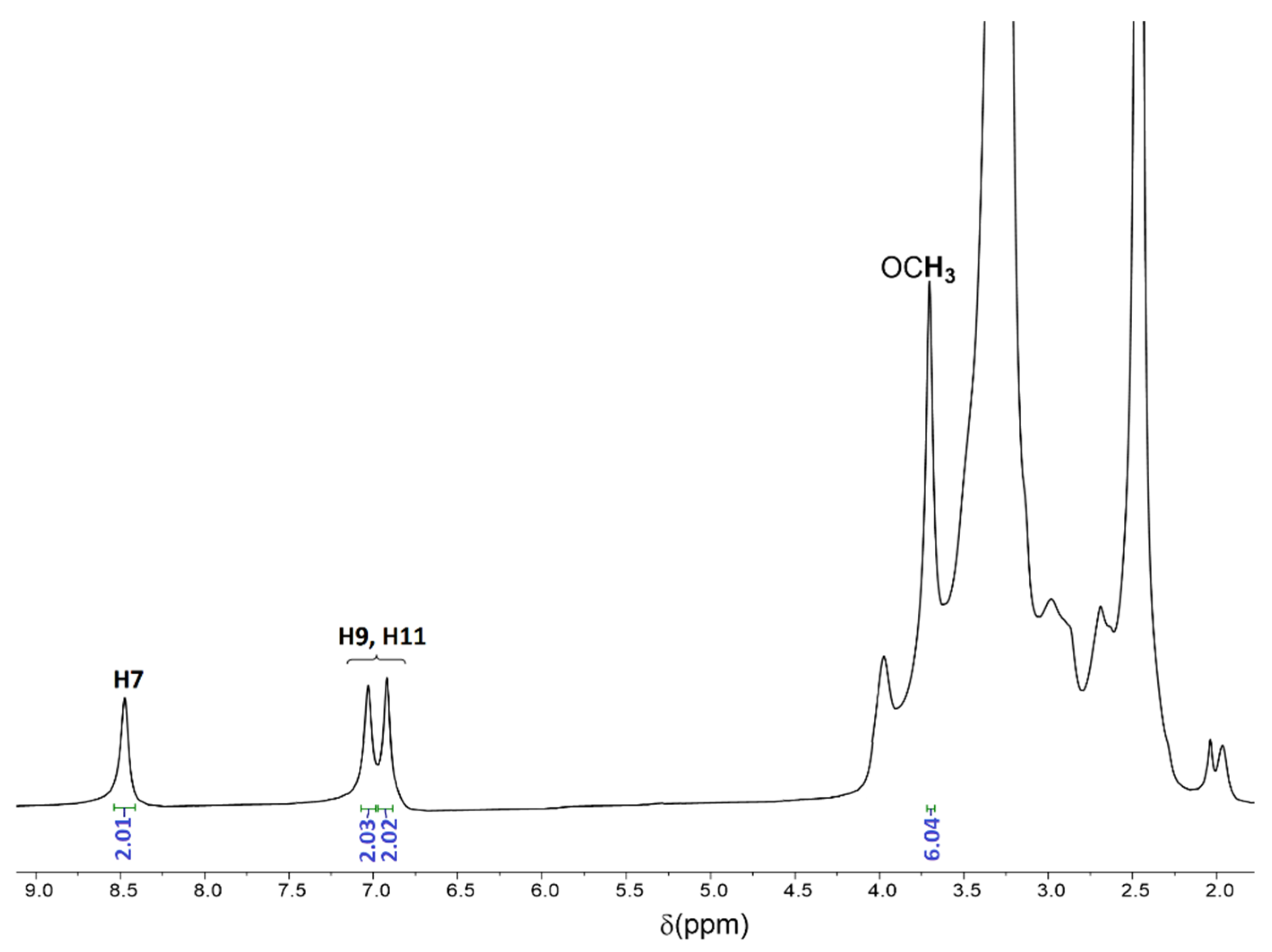Rearrangement of Imidazolidine to Piperazine Rings in the Presence of DyIII †
Abstract
1. Introduction
2. Materials and Methods
2.1. Materials and General Methods
2.2. Syntheses
3. Results and Discussion
3.1. Synthesis and Spectroscopic Characterization
3.2. Single X-ray Diffraction Studies
4. Conclusions
Author Contributions
Funding
Institutional Review Board Statement
Informed Consent Statement
Data Availability Statement
Acknowledgments
Conflicts of Interest
References
- Vitaku, E.; Smith, D.T.; Njardarson, J.T. Analysis of the structural diversity, substitution patterns, and frequency of nitrogen heterocycles among U.S. FDA approved pharmaceuticals. J. Med. Chem. 2014, 57, 10257–10274. [Google Scholar] [CrossRef]
- Sochacka-Ćwikła, A.; Mączyński, M.; Regiec, A. FDA-approved small molecule compounds as drugs for solid cancers from early 2011 to the end of 2021. Molecules 2022, 27, 2259. [Google Scholar] [CrossRef] [PubMed]
- Fondo, M.; Doejo, J.; García-Deibe, A.M.; Sanmartín, J.; Vicente, R.; El-Fallah, M.S.; Amoza, M.; Ruiz, E. Predetermined ferromagnetic coupling via strict control of M-O-M angles. Inorg. Chem. 2016, 55, 11707–11715. [Google Scholar] [CrossRef] [PubMed]
- Kant, R.; Maji, S. Recent advances in the synthesis of piperazine based ligands and metal complexes and their applications. Dalton Trans. 2021, 50, 785–800. [Google Scholar] [CrossRef] [PubMed]
- Cheaib, K.; Herrero, C.; Guillot, R.; Banse, F.; Mahy, J.-P.; Avenier, F. Imidazolidine ring cleavage upon complexation with first-row transition metals. Eur. J. Inorg. Chem. 2017, 2017, 3884–3891. [Google Scholar] [CrossRef]
- Bera, M.; Ribas, J.; Wong, W.T.; Ray, D. A chair-piperazine bridged N,N-dimethylformamide coordinated dicopper(II/II) complex obtained via solution transformation of heterocyclic imidazolidine spacer of a new ligand. Inorg. Chem. Commun. 2004, 7, 1242–1245. [Google Scholar] [CrossRef]
- Zeyrek, C.T.; Elmali, A.; Elerman, Y. Super-exchange interaction in a chair-piperazine bridged dicopper(II/II) complex: Synthesis, crystal structure, magnetic properties and molecular orbital calculations. Z. Naturforsch. B 2006, 61, 237–242. [Google Scholar] [CrossRef]
- SADABS: Area-Detector Absorption Correction; Siemens Industrial Automation, Inc.: Madison, WI, USA, 1996.
- Sheldrick, G.M. SHELXT-Integrated Space-Group and Crystal-Structure Determination. Acta Cryst. 2015, A71, 3–8. [Google Scholar] [CrossRef] [PubMed]
- Sheldrick, G.M. Crystal structure refinement with SHELXL. Acta Cryst. 2015, C71, 3–8. [Google Scholar] [CrossRef]
- Fondo, M.; Ocampo, N.; García-Deibe, A.M.; Sanmartín, J. Zn3, Ni3, and Cu3 complexes of a novel tricompartmental acyclic ligand. Inorg. Chem. 2009, 48, 4971–4979. [Google Scholar] [CrossRef] [PubMed]
- Fondo, M.; Corredoira-Vázquez, J.; García-Deibe, A.M.; Sanmartín, J.; Herrera, J.M.; Colacio, E. Designing ligands to isolate ZnLn and Zn2Ln complexes: Field-induced single-ion magnet behavior of the ZnDy, Zn2Dy, and Zn2Er analogues. Inorg. Chem. 2017, 56, 5646–5656. [Google Scholar] [CrossRef] [PubMed]



| Zn1—O1 | 1.971 (4) | Zn1—N1 | 2.072 (5) |
| Zn1—O10 | 2.367 (6) | Zn1—N2 | 2.155 (5) |
| Zn1—O11 | 2.233 (5) | Zn1—N3 | 2.160 (5) |
| Zn1···Zn1 #1 | 5.943 (1) | ||
| O1—Zn1—N2 | 169.64 (18) | N3—Zn1—O10 | 143.84 (19) |
| N1—Zn1—O11 | 148.21 (18) | O11—Zn1—O10 | 54.68 (18) |
Disclaimer/Publisher’s Note: The statements, opinions and data contained in all publications are solely those of the individual author(s) and contributor(s) and not of MDPI and/or the editor(s). MDPI and/or the editor(s) disclaim responsibility for any injury to people or property resulting from any ideas, methods, instructions or products referred to in the content. |
© 2022 by the authors. Licensee MDPI, Basel, Switzerland. This article is an open access article distributed under the terms and conditions of the Creative Commons Attribution (CC BY) license (https://creativecommons.org/licenses/by/4.0/).
Share and Cite
Corredoira-Vázquez, J.; Oreiro-Martínez, P.; Deibe, A.M.G.; Sanmartín-Matalobos, J.; Fondo, M. Rearrangement of Imidazolidine to Piperazine Rings in the Presence of DyIII. Chem. Proc. 2022, 12, 30. https://doi.org/10.3390/ecsoc-26-13547
Corredoira-Vázquez J, Oreiro-Martínez P, Deibe AMG, Sanmartín-Matalobos J, Fondo M. Rearrangement of Imidazolidine to Piperazine Rings in the Presence of DyIII. Chemistry Proceedings. 2022; 12(1):30. https://doi.org/10.3390/ecsoc-26-13547
Chicago/Turabian StyleCorredoira-Vázquez, Julio, Paula Oreiro-Martínez, Ana M. García Deibe, Jesús Sanmartín-Matalobos, and Matilde Fondo. 2022. "Rearrangement of Imidazolidine to Piperazine Rings in the Presence of DyIII" Chemistry Proceedings 12, no. 1: 30. https://doi.org/10.3390/ecsoc-26-13547
APA StyleCorredoira-Vázquez, J., Oreiro-Martínez, P., Deibe, A. M. G., Sanmartín-Matalobos, J., & Fondo, M. (2022). Rearrangement of Imidazolidine to Piperazine Rings in the Presence of DyIII. Chemistry Proceedings, 12(1), 30. https://doi.org/10.3390/ecsoc-26-13547










